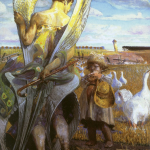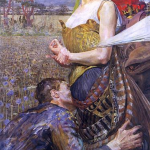
Johan Thorn Prikker assumed the role of Professor for Painting at Kölner Werkschule (predecessor of KISD) from 1926 to 1932. Despite the time frame of his work predating the current century, Prikker’s life and artistic output still present us with profound insights into the intricate connections between art and craftsmanship, art and society, and art and spirituality. Drawing upon the wisdom of Aristotle, Giambattista Vico, and Friedrich von Schiller – intellectuals whose discourse features prominently in my KISD seminar, “The Eye Is Part Of The Mind” – I contend that Prikker’s comprehensive perspective offers a thought-provoking lens through which to view the realms of art and politics, particularly in light of contemporary reinventions of the therapeutic potential of art. Indeed, Prikker’s seemingly ornamental paintings and designs were never intended to simply serve as aesthetically pleasing decorations. Prikker’s vast artistic repertoire, coupled with his endeavors as an educator, curator, and designer, stem from his (romantic) conviction that art has the power to liberate the human imagination, ignite euphoric states and chaos, and that these experiences are crucial for true emancipation of creativity!
www.ftn-books.com has several Thorn Prikker pulbications available.


























































